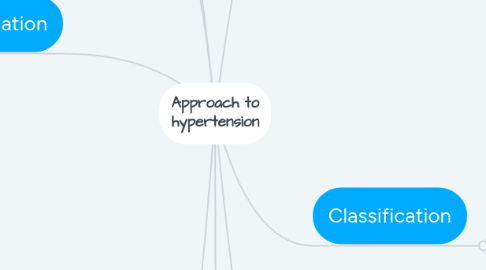
1. Definition
1.1. Persistent elevation of SBP ≥ 140 mmHg and/or DBP ≥ 90 mm Hg
2. History
2.1. Lifestyle
2.1.1. • Smoking • Physical inactivity • Alcohol intake
2.2. - Family history of HTN - Symptoms of secondary HNT - Hx or Symptoms of target organ damage
2.3. Drug Hx:
2.3.1. - Oral contraceptives - Steroids
2.4. RF for CVDs
2.4.1. • Male • HTN • Obesity (BMI ≥ 30 kg/m2) • M > 55, F > 65 Y/O • DM • Dyslipidemia • Cigarette smoking
3. Basic investigation
3.1. Urinalysis
3.1.1. Protein
3.1.2. Glucose
3.1.3. Blood
3.2. Blood chemistry
3.2.1. Potassium,
3.2.2. Sodium
3.2.3. Creatinine
3.2.4. FBG
3.3. Lipid profile
3.4. ECG
4. Management
4.1. Main goal for management
4.1.1. ○ in antihypertensive therapy at least to reduce SBP to 140 mmHg and DBP to 90 mmHg ○ To reduce risk of CVD and renal morbidity and mortality
4.2. Non pharmacological (For prehypertension)
4.2.1. Lifestyle modification for 3-6 months
4.2.1.1. Weight loss (most effective): ⬇︎ SBP: 5-20 mmHg /10 kg
4.2.1.2. DASH dietary plan - Rich fruits, vegetables - Low fat dairy products - ⬇︎ SBP: 8-14 mmHg
4.2.1.3. Dietary sodium reduction - < 100 mmol/day - ⬇︎ SBP: 2-8 mmHg
4.2.1.4. Physical activity: ⬇︎ SBP: 4-9 mmHg
4.3. Goal of BP in JNC8 panel (if higher pharmacological treatment)
4.3.1. ○ ≥ 60 Y/O without comorbidities: < 150/90 mm Hg ○ < 60 Y/O without comorbidities: < 140/90 mm Hg ○ ≥ 18 Y/O with chronic disease: < 140/90 mm Hg
4.4. Pharmacological
4.4.1. 1st line
4.4.1.1. Thiazide diuretics Calcium channel blockers (CCB) ACEIs, Angiotensin receptor blockers (ARBs) NB: Do not join (ACEI&ARB) = hyperkalemia If SBP ≥ 20 and DBP ≥ 10 mmHg above goal, Initial therapy: 2 agents, one of them thiazide type diuretic
4.5. Resistant hypertension
4.5.1. Failure to reach goal BP in patients who are adhering to full doses of three-drug regimen that includes a diuretic
4.5.2. Causes of Resistant Hypertension
4.5.2.1. 1. Poor adherence 2. Failure to modify lifestyle e.g. obesity 3. Inadequate drug regimen. 4. White-coat HTN 5. Medications and substances : a. cocaine, b. amphetamines, c. oral contraceptives. 6. Secondary causes: a. Hyperthyroidism, b. cushing’s disease.
5. Physical examination
5.1. BMI & waist circumference
5.2. Signs of Target organ damage
5.2.1. Vascular
5.2.1.1. Absent arterial pulses,
5.2.1.2. Carotid and femoral bruits,
5.2.1.3. Abnormal aortic pulsation
5.2.2. Brain: motor or sensory defects
5.2.3. Cardiac
5.2.3.1. arrhythmia,
5.2.3.2. basal lung crackles,
5.2.3.3. peripheral edema
5.2.4. Retina: fundoscopic abnormalities
5.3. RED FLAG for secondary HTN
5.3.1. Signs of secondary HTN
5.3.1.1. Coarctation of the aorta
5.3.1.1.1. - Arm to leg SBP difference > 20 mmHg - Brachial femoral pulse delay
5.3.1.2. Renal artery stenosis
5.3.1.2.1. - Renal bruit - ⬆︎ serum creatinine concentration (≥ 0.5-1 mg/dL after starting ACE inhibitor or angiotensin receptor blocker (ARB)
5.3.1.3. Thyroid disorder
5.3.1.3.1. ○ Tachycardia/bradycardia ○ Cold/heat intolerance ○ Constipation/diarrhea ○ Irregular, heavy or absent menstrual cycle
5.3.1.4. Primary Aldosteronism
5.3.1.4.1. hypokalemia
5.3.1.5. Obstructive sleep apnea
5.3.1.5.1. - Apneic events during sleep - Day time sleepiness - Snoring
5.3.1.6. Pheochromocytoma
5.3.1.6.1. ○ Orthostatic hypotension ○ palpitations
5.3.1.6.2. Diagnostic test
5.3.1.7. Cushing syndrome
5.3.1.7.1. Cushingoid body habitus
5.3.1.7.2. - Hyperglycemia - Proximal muscle weakness
5.3.2. - Age < 30 - No family hx of HTN - Persistent HTN (ليست قراءة عابره) - Non-obese - MI symptoms: • chest pain, ECG changes STEMI or non STEMI - CHF symptoms: • edema, dyspnea, cant's sleep (multiple pillows)
6. Classification
6.1. - Normal blood pressure • SBP: < 120 • DBP: < 80
6.2. - Prehypertension • SBP: 120-139 mm Hg • DBP: 80-89 mm Hg
6.3. - Hypertension stage 1 • SBP: 140-159 • DBP: 90-99
6.4. - Hypertension stage 2 • SBP: ≥ 160 • DBP: ≥ 100
7. Diagnosis
7.1. - Three different visits; at least one week apart - At least 2 measurement at each visit - JNC8: • Should be two reading abnormal • SBP ≥ 140 mmHg and/or DBP ≥ 90 mm Hg
7.2. Ambulatory BP: • 24-48hr • 24hr BP ≥ 130/80 mm Hg is hypertension • Mean daytime BP ≥ 135/85 mmHg is hypertension • Every 15-20 min daytime, 30-60 min during sleep
7.3. Home BP measurement • Al least 12-14 measurements • One week period Mean all reading of BP ≥ 135/85 mmHg is hypertension
8. special setiation
8.1. Women with HTN
8.1.1. - OCP increase risk for HTN (within 6-12 weeks) - If women in childbearing age: give advise if she want to be pregnant stop ACEs & ARBs (-pril &-sartan)
8.1.2. Hypertension in pregnancy
8.1.2.1. Management
8.1.2.1.1. ○ Methyldopa: 1st line choice ○ BBs (labetalol) ○ CCBs § Nifedipine, § Verapamil: for women with DM, mico/macor proteinuria planning pregnancy ○ Vasodilators ○ Hydralazine, ○ DM + proteinuria: want to get prengant = verapamil (CCB)
8.1.2.2. CI
8.1.2.2.1. ○ ACEIs & ARBs: (-pril & -sartan) ○ Breast feeding: some type CI, but you have other classes be safe and avoid ACEI & ARB during breast feeding ○ SE: § fetal defect § Neonatal renal failure
8.2. HTN during Ramadan
8.2.1. - Diuretics: better avoided or taken early evening - Once daily dosage with long acting (recommended) - Difficult to control HTN: advice not to fast
8.3. HTN and Hajj
8.3.1. - Severe HTN not fit for Hajj - Once daily regimens recommended - Diuretics better avoided

